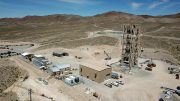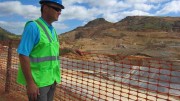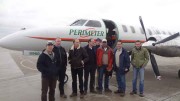Looking down into the deep ravine in the centre of New Pacific Metals’ (TSX: NUAG) Silver Sand project in central Bolivia, one does not have to be a geologist to spot its potential. Up and down its steep sides, the landscape is pockmarked by adits and tunnels dug by miners almost five hundred years ago.
The miners may have left after the discovery in 1545 of Cerro Rico, Bolivia’s legendary mountain of silver, just 35 km away, suggests New Pacific’s VP exploration Alex Zhang. That’s been to New Pacific’s gain. After acquiring the project six years ago, the company has undertaken the first modern exploration of the site, identifying silver mineralization that could soon support the country’s next major silver mine.
An initial resource published in early 2020 pegged measured and indicated resources at almost 156 million oz of silver in 35.4 million tonnes at an average grade of more than 137 grams silver per tonne. Since then, despite the restrictions imposed by the pandemic, the company has continued to explore, expanding Silver Sand, located about 180 km southwest of the city of Oruro, and adding new projects to its portfolio.
A first mover into Bolivia, New Pacific Metals is building on its early success. And backed by major shareholders Silvercorp Metals (TSX: SVM) and Pan American Silver (TSX: PAAM), which together own almost 40% of the company, New Pacific could now be on the cusp of realizing the gains of its early bet on Bolivia’s potential.
Despite a proud mining heritage, investors had largely avoided landlocked Bolivia following a spate of nationalizations under leftist strongman Evo Morales who ruled the country until 2019.
But with natural gas reserves dwindling — threatening its main revenue source — a new government realizes it needs foreign capital and knowhow to revitalize the mining sector. President Luis Arce’s economic plan calls for five new mines to be brought into production by the time he faces elections in 2025. That will be a tall order, but Silver Sand is well-positioned to be in the first rank.
Upcoming PEA
With an updated resource estimate on the horizon, New Pacific plans to complete a preliminary economic assessment by the end of the year which should lead to a prefeasibility study during 2023. In parallel, the company has begun applying for an environmental permit which it expects to obtain by next year allowing construction to begin in 2024.
The team has also ready identified possible locations for the mill and tailings facility.
New Pacific is no longer the only company pursuing Bolivia’s considerable mineral potential. Since it acquired Silver Sand, more than half a dozen mining companies have moved into the country acquiring both operating mines and exploration projects. Earlier this year Santacruz Silver Mining (TSX: SCZ) closed a deal to buy three operating zinc mines and a trading station from Glencore, Andean Precious Metals (TSX: APM) has bought the San Bartolome mine on the slopes of Cerro Rico, while Eloro Resources (TSX: ELO) is exploring the Iska Iska project in southern Bolivia.
But while competition has increased for assets, New Pacific is taking advantage of its first mover status.
In 2021, the company staked the Carangas project in the arid plans of western Oruro province, close to the border with Chile. Like Silver Sand, the site shows widespread evidence of colonial-era mining, including shafts and slag piles.
Carangas resource
Unlike Silver Sand, which is located in Bolivia’s silver-tin belt, Carangas sits in the Andean epithermal belt which runs up the Chilean Andes and into southern Peru, hosting some of the world’s largest copper-gold deposits, including Quebrada Blanca and Collahuasi. However, the belt has seen little exploration on the Bolivian side of the border.
Following Spanish mine workings, Zhang and his team initially concentrated drilling on the large hill, named West Dome, which dominates the site, establishing the existence of a wide area of near-surface silver mineralization, measuring 700 metres wide by 1 km long.
But drilling in the valley intercepted a broad area of high-grade gold mineralization underlying the silver zone. One hole intercepted almost 600 meters of mineralized rock grading 1 gram per tonne of gold.
“Once we started drilling, we couldn’t stop because every hole hit a very long intercept of mineralization,” explained Zhang. Last year’s 3,000-metre campaign quickly expanded to 13,000 metres.
Encouraged by the find, the company is drilling 40,000-metres at Carangas this year with the aim of building up its knowledge of the discovery as quickly as possible.
New Pacific now has five rigs turning round the clock at the site, two assessing the size of the silver mineralization and three chasing the gold. To test the depth of the gold mineralization, the company has drilled the deepest hole ever drilled in Bolivia.
The company is planning to publish a first resource for the site as soon as the middle of next year.
“Some exploration companies would spend years and years getting to a mineral resource. We want to create value for shareholders fast,” explains Zhang.
Although the project remains at an early stage, New Pacific’s success at Carangas has already attracted the praise of authorities in Bolivia.
Visiting the site in early September, Mining and Metallurgy Minister Ramiro Villavicencio welcomed the company’s positive results and the impact of the project on the local economy.
“This is going to bolster mining in Oruro and not only in tin. We are talking about mining continuing until 2050,” he said.








Be the first to comment on "SITE VISIT: New Pacific advances Bolivian silver project towards late 2022 PEA"